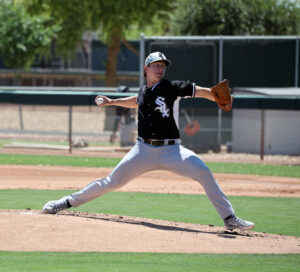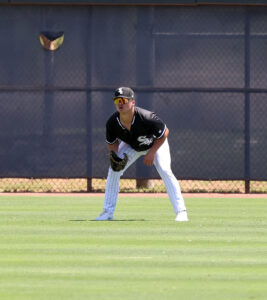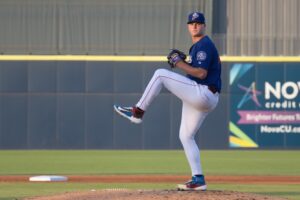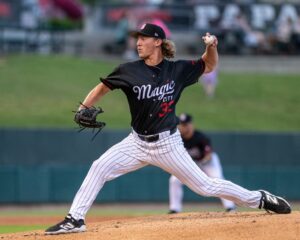Prospect Focus: Bryce Bush
Nick Hostetler and his scouting staff have used the third day of major league baseball’s amateur draft to add legitimate talent to a White Sox farm system teeming with talent of late. Day three (rounds 11 through 40) is usually a good time to add overlooked college transfers and once proud options coming off poor seasons. In rebuilding a farm system lacking fundamentally sound baseball players, the front office and scouting staff have homed in on college performers recently. That trend continued this year but there were some high upside prep players mixed into the most recent draft haul and that was a slight departure from the perceived modus operandi.
One of those heralded prep players is Bryce Bush. Bush attended De La Salle Collegiate High School in Warren, Michigan, an all-boys Catholic high school run by the Christian Brothers. Major League veteran catcher Alex Avila and former New York Mets General Manager Steve Phillips are some notable alumni from the school. Prep athletes taken towards the end of the amateur draft generally don’t sign big league contracts. Those players are usually drafted as a favor from a major league club or as a way of making a connection for a possible pay-off in the future. High school players that forego college and sign with clubs usually go much higher than the 33rd round. The White Sox Director of Amateur Scouting told me that Bush wasn’t the complete long-shot that fans and followers assumed when the pick was made.
“In general, most high school picks that late usually are a complete flyer; maybe ninety percent of the time. In this case it wasn’t, due to our area scout Justin Wechsler.”
Wechsler was himself a 4th round draft pick of the Arizona Diamondbacks out of Ball State University back in 2001, after being a 2nd Team All-Mid-American-Conference player for three straights years in Muncie. He became a baseball scout after playing six years in the minor leagues and now he focuses on building relationships to give himself a competitive edge. He was born in Anderson, Indiana and now serves as an area scout for the White Sox covering Indiana, Michigan, Northern Ohio, Western Pennsylvania and Canada. It’s often hard to scout in the Midwest due to shorter high school seasons and ghastly weather but his relationship building played a big factor during the scouting process this year according to Hostetler.
“Justin’s ability to stick on the player while battling through lots of cold weather was key. He knows those players extremely well and that’s one of the most important things as an area scout in general, but Justin specifically knows the ins and outs of his players.”
Back to Bryce, his profile at Perfect Game USA called him a “right-handed hitter with a strong athletic build and room to grow stronger”. The Michigan prep sensation was lauded for his bat speed and very quick hands that cause baseballs to explode off the barrel. The publication surmised that Bush has the ability to drive the ball long and far, and also possesses clean infield actions on the defensive side. He was a 2018 Rawlings Perfect Game 1st Team All American (Central-All Region 1st Team), 2017 Underclass 3rd Team selection, and 2016 Underclass High Honorable Mention selection as well. Hostetler confirmed that he didn’t see Bush play this past season but noted that he’d seen him the previous year at the East Coast Showcase and the Perfect Game All-American Game. He liked what he saw.
“I really liked the bat to ball skills. Everything he put the barrel on he hit hard. He’s a good, solid athlete with premium bat speed. Bryce played all over the dirt which was intriguing to me.”
Wechsler’s days of scouting Bush go back to Bryce’s sophomore year in high school. The area scout admitted that he just kind of ran into him while scouting and followed along closely after seeing him and meeting Bryce’s father. Justin saw Bryce on the showcase circuit as well, which helps due to the league and conditions in Michigan. De La Salle plays in a High School Catholic League in which the talent isn’t bursting in the same ways as other prep leagues. Bryce’s dad would often throw batting practice for the scouts in attendance so they could see something other than Bush being pitched around all game. As Hostetler stated effusively, Wechsler developed a great relationship with the kid and his father. The White Sox road warrior loved the tools that Bush displayed on the field as well:
“I saw incredible power and shortness to the ball. Every time he swung the bat it was contact and it was hard contact. Not a lot of pull. It was up the middle and he can drive the ball the other way. He was really aggressive and controlled the zone okay. I thought he had a good arm, could run a little bit and was position-flexible.”
White Sox decision makers weren’t the only ones with high praise for Bush. His coaches back at De La Salle gave rave reviews as well. Strength and Conditioning Coach Scott Grimmer noted that “things just looked different with Bryce.” He said that Bush would make plays that no one else on the team could make and reminisced about times that he would snag a grounder deep in the hole at shortstop and then display the arm strength to make the out at first with room to spare. Grimmer described Bryce as a “laid-back kid that led by example who was really well put together physically for as young as he is.”
Grimmer is a coach on the football staff at De La Salle and often thought about how great Bryce would translate to the gridiron. Scott thought that Bush was a standout athlete who could have excelled in any sport. He even cited a specific example off the top of his head.
“His junior year, kids were shooting hoops in the gym. Bryce walked over and took a one-step approach and dunked the basketball.”
Steve Schypinski is the head baseball coach at De La Salle High School and he stated emphatically that Bush is the best player he’s ever coached. Schypinski raved about the natural gifts that Bryce inherently brought with him to the proverbial table on a daily basis. He confirmed his former player’s advanced understanding of the strike zone. Steve noted that he’s a tough out because he rarely chases bad pitches outside the zone but he’s also familiar with getting pitched around due to being the best hitter on his team and batting in the middle of the lineup. Bryce’s entire field approach and opposite field raw power were mentioned as strengths as well. It didn’t take very long for Schypinski to realize that what he was seeing was different than what he’d been used to.
“We have known Bryce was a special talent from the minute he stepped on our campus. Bryce has amazing baseball instincts to go along with the quickest hands I have ever seen for a high school baseball player. He displayed these instincts from the start and simply continued to get better and better as his career went on.”
Bush Off To a Hot Start
The Michigan teenager hasn’t missed a beat – or a fastball, seemingly – since donning uniforms for a White Sox affiliate for the first time. The 6’0″, 205 pound 18-year-old got off to a hot start while playing for the Low-Rookie Level affiliate in the AZL. Over 52 plate appearances across 14 games in the Fire League, Bryce hit his first professional home run as part of slashing .442/.538/.605 with only 4 strikeouts against 8 walks. His 214 wRC+ and .537 wOBA were staggering for a player in his debut.
Here’s a a closed-side video of an at-bat from his professional debut game:
Bush has since been promoted to the Pioneer League to play for the White Sox Advanced Rookie Level affiliate in Great Falls, Montana. The right-handed slugger has only suited up in three contests so far for the Voyagers (he joined the team just before their All Star Break) but already has a couple extra base hits including a home run. Bush notes that while his eye at the plate is known to be strong, some of the raw pitchers in the AZL contributed to his increased walk rate:
“Coming to Great Falls is the biggest adjustment so far. Pitchers in the AZL throw real fast, sometimes in the nineties, but no idea where it’s going. Pitchers in Great Falls don’t throw as hard but they’ve got real good command and movement on their pitches. That’s probably the biggest adjustment.”
While Hostetler enjoyed the fact that Bush played all over the infield during showcase events, Bryce told me that he played mostly at shortstop during his most recent high school season. The White Sox drafted him and announced him as a third baseman and many scouts told Bush that they thought he’d end up fitting best in the outfield. He wasn’t even sure if they were serious about him sticking at the hot corner.
“I’ll tell you, third base is extremely hard. It might be the hardest infield position because of the bullets that get hit at you. I played shortstop in high school and most scouts said they thought I fit best in the outfield. I honestly thought the White Sox might just stick me in the outfield anyway as well.”
Alex Rodriguez and Miguel Cabrera were two players that Bryce admired as a child. Both of those players have some third base in their past and Bush is trying to stay over there as well. Hostetler and his staff are excited to see his development at third base while he acclimates to professional baseball.
“I didn’t think he had one position” said, Hostetler. I felt like he just needed a little bit of work and he could end up sticking at third base so it’s been kind of fun watching his defensive development on our end even as much as his offensive development.”

Bush recently tweeted that signing a contract with the Chicago White Sox is one of the best decisions he’s ever made. It would seem obvious to some that receiving almost $300,000 to play baseball would be a good decision. Bryce had other options though, via a significant baseball scholarship to Mississippi State.
“I always wanted to play baseball and I had the option to go to Mississippi State and had a rare scholarship there too. I chose to go pro to start my career as soon as possible and get to the MLB as soon as possible”. Bryce also said, “The coaching change at Mississippi State didn’t factor into my decision. I always wanted to go pro.”
Even though he hasn’t had the chance to figure out his favorite dinner spot in Montana yet, the early returns on his decision have been good. He’s even struck up a friendship with fellow 18-year-old infielder Lenyn Sosa despite a challenging language barrier while playing for the Voyagers.
How Did The White Sox Land Bryce Bush?
By all accounts, it seems Bush was considered by many scouts and draft analysts to be a talent worthy of a selection in the top 6 rounds of the draft. He fell to the 33rd round, seen as a tough sign given that college commitment. Hostetler stated that Bush was a “top five round talent”. Wechsler had similar thoughts. Grimmer feels comfortable that he knows the look of a pro athlete and he feels that Bryce has “it”. Bryce’s former head coach Steve Schypinski thought that Bush’s summer experiences really helped him.
“The draft process was an awesome learning experience for our entire baseball staff”, said Schypinski. “Bryce works extremely hard and played in a very competitive summer league on the east coast with some of the best players in the country allowing him to gain a lot of exposure. We had between 3-5 [major league] teams at almost all of our games, especially in May.”
There are all sorts of reasons why a kid as talented as Bryce could fall to late on day three of the draft, and usually those reasons make a signing unlikely. The way that bonus pool money is distributed to major league teams makes it almost a foregone conclusion that all of a team’s draft picks in the first ten rounds will become members of the organization. Many prep players with strong college commitments are deemed unsignable and therefore don’t get drafted in a round that is commensurate with their true talent level. Other times, players that do their business in the north and Midwest get overlooked or under-scouted due to a shorter season and travel difficulties related to weather. Bush was clear that the teams he spoke with were told that his college commitment wouldn’t be a sticking point in regards to signing a contract.
“We told every team that I wanted to go straight out of high school. I also wasn’t asking for that much money to do so”. He also said that he wasn’t sure which team would pick him even though multiple area scouts had been in to see him play. In regards to where and by whom he would be drafted, Bryce said, “I didn’t really know. Lots of teams showed interest. I actually thought the White Sox showed the least amount of interest at first”.
The White Sox had a solid idea of what it would take to sign Bryce to a pro contract. Hostetler gave Wechsler all of the credit as was stated earlier, but he also mentioned that the draft’s bonus allotments can be tricky and that it was a process to hammer out a deal.
Hostetler said, “The main thing for me was Justin’s ability to know the player in an out and what it would take to sign. He knew about Bryce’s ambitions to play pro ball and the work we put into scouting him the summer beforehand, our national and regional guys getting to lay eyes on Bryce so we weren’t completely blind going into the season and having to deal with the weather. Justin Wechsler was well aware that the kid wanted to play and the family had interest in signing. We knew after the pick was made that there’d be an opportunity should we have the ability and financial flexibility to sign him. We had to wait a little bit to make sure that all the guys we had agreements with prior would get into camp and pass their physicals. After this happened, we started talks with the agent, family and kid and had an agreement in place about a week-and-a-half to two weeks before the agreement was officially announced”.
Schypinski doesn’t believe that playing in the north factored into Bush falling to the 33rd round. The veteran coach thought that the exposure Bryce was getting in the summer along with all of the showcases made him well known enough to convince scouts. Steve confirmed that he had contact with all 30 major league clubs regarding Bryce. Hostetler mentioned that the earlier draft could have in fact been a detriment and one reason why Bush was overlooked for so long. he said this in regards to Bryce falling to round 33:
“I think the weather played a part in it. When you don’t have as much time to get to those players it matters. Two years ago, I believe the draft was June 10th-12th. This year’s draft was a whole week earlier and in the grand scheme of things, kids in Ohio, Illinois, Indiana, Wisconsin and Michigan and cold weather schools that start later and play later; that’s one less week to get cross-checked or seen by a scouting director.”
The White Sox Coup
The stakeholders in this process have varying opinions on how the White Sox ended up with a 5th-6th round talent late on day three. Perceived signability concerns were one issue. Playing in Michigan weather seemingly mattered as well. The earlier date for the draft was another factor.
Hostetler deserves a tremendous amount of credit for drafting the talented prospect. Hostetler didn’t see Bush play a single game this past season. Similarly to how he’s operated in the past however, Hostetler leaned heavily on his staff and trusted the opinion of his area scout. The area scout had a read on the kid’s intentions and what it would take to construct a deal, and Hostetler let him do his job. It is possible that the White Sox got a bit lucky but with most good things, luck is notoriously one of the factors. Bush told me that unlike the White Sox, other teams had a different process.
“Some scouts have told me that!” said Bush, in reference to not drafting him after showing a wide degree of interest. Bryce believes that there were area scouts from other clubs that were definitely interested in signing him. Those scouts didn’t benefit from the same clout that Justin Wechsler did though. Some clubs won’t draft a player unless a high-ranking official sees that particular prospect in person. Due to a multitude of factors, some scouting directors and cross-checkers just didn’t have the time to see a Catholic League Prep hitter from the state of Michigan.

The White Sox benefitted from this. The organization also spent over $12,500,000 on this year’s draft. They came in with a bonus pool of $10,589,900. Bush was given an over-slot bonus of $290K. The club also went over their pool amount to finish deals with other players and they spent a total of $369,500 more than their original pool. The White Sox were required to pay an overage tax of 75% for another $277,125. Hostetler lauded the organization for their commitment to adding talent.
“It’s not usually our past. We haven’t been known to be big spenders and go over like that but it shows the commitment from ownership and the front office to adding as much talent as possible. As Rick [Hahn] said, we needed to continue to influx the system with as much talent as possible due to things out of our control that could happen and this is a prime example of that in going over the pool to add a player that we believe has top five round talent.”
When Bryce Bush was drafted, most people assumed that he would end up at Mississippi State. When he signed a deal with the White Sox, there were a plethora of questions as to why and how. When he torched the Arizona Rookie League, there were questions about whether he should go to Great Falls as an 18-year-old. When he was left off of our 2018 midseason top 30 prospects list here at FutureSox, fans wondered aloud if we were out of touch (in truth we just didn’t know enough yet). If Bryce continues his torrid pace, at his age, while playing in the Pioneer League, there’s a solid chance that he’ll be on the next list that we compile.
One person that isn’t at all surprised with Bryce’s success however is Coach Schypinski:
“I’m not surprised at all by his early success in pro ball. Bryce works very hard, never gets too up or too down and is extremely motivated to reach his goals. He understands that baseball is a game of failure and has the same approach at the plate regardless of where his batting average sits. Bryce is also extremely athletic and understands that he can impact the game in many different ways outside of the batters box.”
So far, it looks like Schypinski’s instincts were right. And White Sox fans can have hope it will continue.







I noticed in your post a 2 weeks ago on the Sox top prospects injuries and there was no mention of Victor Diaz? Whatever happened to that guy?